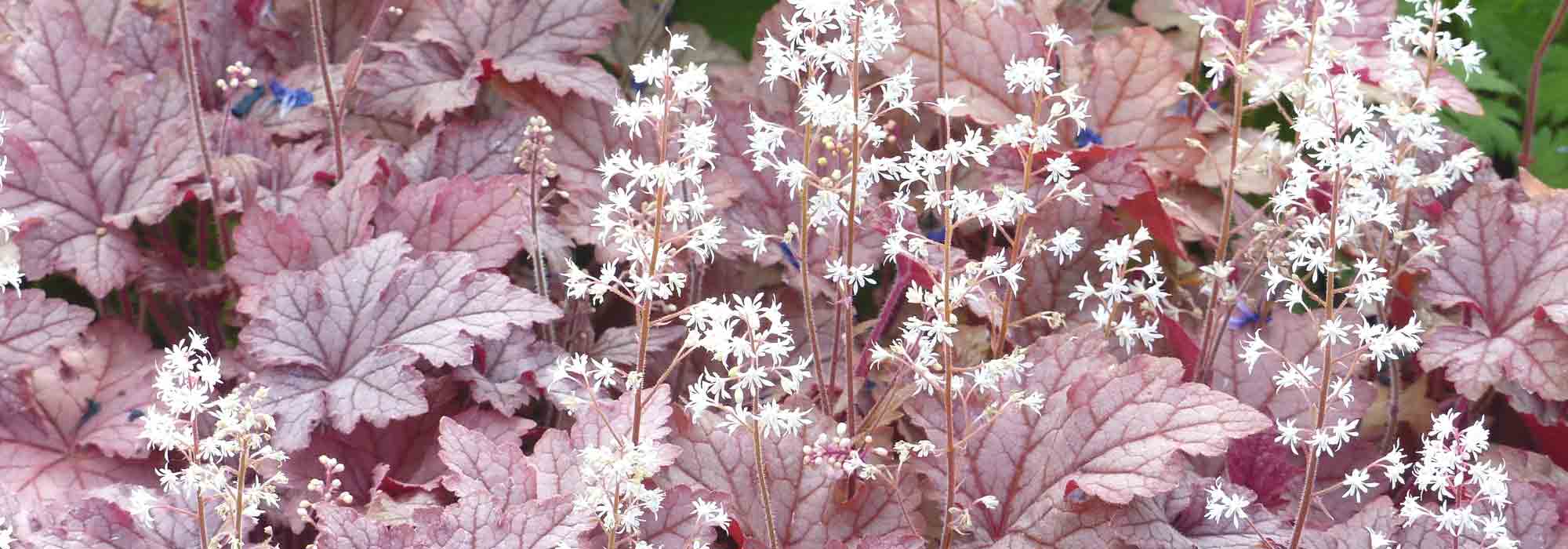
Tiarella and Heucherella: planting and growing
Contents
Tiarellas and Heucherellas in a nutshell
- Tiarellas and heucherellas display highly decorative foliage, with a great diversity of colours and pretty hues from the first frosts
- Their delicate, feathery flowering in white or pale pink is irresistible
- Very hardy perennials, usually evergreen, these perennial plants are attractive ten months of the year
- Woodland plants, they prefer cool soils and shady or semi-shaded positions
- Excellent groundcover for cool shade where they spread generously, they can also be planted in tubs or planters
A word from our expert
Tiarellas and Heucherellas, together with heucheras, are among the best perennials with colourful foliage!
Heucherellas or X Heucherella are magnificent hybrids that benefit from long flowering of tiarellas and colourful, evergreen foliage of heucheras or Heuchera.
These perennial ground-cover plants with discreet, modest charm are much appreciated for brightening shady, cool corners and wooded areas of garden.
With their very decorative, evergreen foliage, which changes with temperature and seasons, they bring colour and brightness to garden for much of year, even in deepest winter.
They quickly form dense tapetum topped by very luminous, vapoury spikes of white or pink flowers. This abundant, long flowering will illuminate slightly dark areas of garden from spring through to autumn.
From Tirarella cordifolia to Tiarella wherryi, or to hybrid tiarella ‘Ninja’ and their cultivars such as ‘Morning Star’, ‘Pink Symphony’, ‘Sugar and Spice’, to multiple varieties of Heucherella like ‘Stoplight’, ‘Sweet Tea’, ‘Solar Eclipse’ or ‘Tapestry’, all will continue to surprise with their foliage of exceptional colours!
These new cultivars, ever more numerous each year, are now available in very varied, often bicoloured shades ranging from acid green to bright golden yellow, through deep purple to tea-rose.
Easy to grow, low-maintenance and very hardy, they reduce weeding and can even replace lawn to good advantage in cool spots.
These generous, feathery perennials prefer humus-bearing, well-drained, cool soils and a semi-shaded position or shelter from burning sun.
Although they can be grown in ground alongside their cool-shade companions such as Astilbes and hostas, don’t hesitate to plant them in pots or containers to create delicate compositions combined with small bulbous plants or grasses.
Beautiful even in winter, vigorous and floriferous, with their unique foliage, our Tiarellas and Heucherellas deserve a prime spot in garden. They will not disappoint!
Foliage lovers, discover all our evergreen ground-cover perennials!
Description and botany
Botanical data
- Latin name Tiarella, x Heucherella, Heucherella
- Family Saxifragaceae
- Common name Tiarella, Heucherella
- Flowering February to November depending on species
- Height 0.10 to 0.90 m
- Exposure Shade, partial shade
- Soil type All, well-drained
- Hardiness -15°C to -20°C
Tiarella and Heucherella both belong to family Saxifragaceae. They are close relatives of Heuchera, with which these two perennials hybridise easily. Heucherella is in fact the result of hybridization between Heuchera and Tiarella: X Heucherella is a hybrid genus created in 1912 that combines the best characteristics of both parents: decorative foliage and a dense, long flowering season.
Genus Tiarella includes seven herbaceous, rhizomatous perennial plants with ornamental foliage, native to cool woodland understoreys and stream banks of North America and Asia. The species most commonly seen in gardens are Tiarella cordifolia, the cordate Tiarella, which spreads by rhizomes without ever becoming invasive, and Tiarella wherryi, which has no stolons and a slower growth habit.
About thirty Heucherella varieties exist at present, not counting new cultivars introduced each year.
Most Tiarellas and Heucherellas have a spreading habit. Some varieties (‘Tiarella Running Tiger‘) spread rapidly via leafy stolons that root much like strawberry runners, creating new plants and forming large tapetum groundcovers 10 to 90 cm high and equally wide at maturity.
The smallest varieties measure under 20 cm in leaf height, while larger cultivars reach at least 50 cm in height. Some, such as ‘Heucherella Redstone Falls‘, produce gracefully trailing stolons.
Tiarella wherryi or Wherry Tiarella is notable for an erect habit, forming clumps that are wider than tall and not exceeding 45 cm in height at maturity for a slightly greater spread.
Tiarellas and their hybrids, the Heucherellas, belong to a group of perennials characterised by very decorative foliage with incredibly varied colours and textures. However, distinguishing the two can be difficult due to their close similarity; differences depend on genus and cultivar.

Some Tiarella foliage: T. ‘Appalachian Trail’, T. polyphylla and T. cordifolia ‘Mint Chocolate’
In spring, thick stems give rise to rosettes of evergreen to semi-evergreen leaves depending on winter severity. Basal leaves are usually ovate, heart-shaped or rounded, about 5 to 15 cm long. They are simple or divided into 3 to 7 lobes of varying depth or palmate with a dentate margin and sometimes long petiolate, resembling maple leaves. Heucherella leaves are smaller but equally colourful as those of Tiarellas, sharing similar elegance.
Highly dissected, leaves display warm, vivid tones, solid, variegated or marbled, which change subtly with temperature, often more strongly coloured in spring and autumn.
Silky or glossy, colours range from tender green to emerald, sometimes shaded with red or bronze-purple; depending on cultivar there may be a central maculate or bold, contrasting veins, often purple on a clear green lamina. Foliage often turns coppery in autumn before developing a deep red that can cover almost the entire lamina as cold weather sets in.

Some Heucherella foliage: H. ‘Copper Cascade’, H. ‘Solar Eclipse’, H. ‘Tapestry’, H. ‘Stoplight’
New hybrids offer remarkable colours from chartreuse green to golden or silvery, through apricot-orange, coppery red, rose veined with purple or glazed black-purple. They may develop cinnamon, copper-orange, powder-pink or ruby tones by mid-summer. Prominent venation often enhances leaf patterns attractively.
In spring, slender pubescent stems, sometimes reddish-brown, rise from the rosette of small leaves. From April to August, sometimes into autumn for Heucherellas depending on climate, tiny star-shaped or bell-like flowers 1–10 mm in diameter grouped in light panicles or loose clusters open, sometimes held up to 50 cm above the foliage, forming a frothy floral display. Flowering stems are shorter in Tiarellas.
This pretty, foamy cone-like bloom is mainly spring-flowering, February to June for Tiarellas, and summer to autumn for Heucherellas. But both flower abundantly.
These airy spikes, white, creamy-white or pinkish, later develop into shiny black capsule fruits.
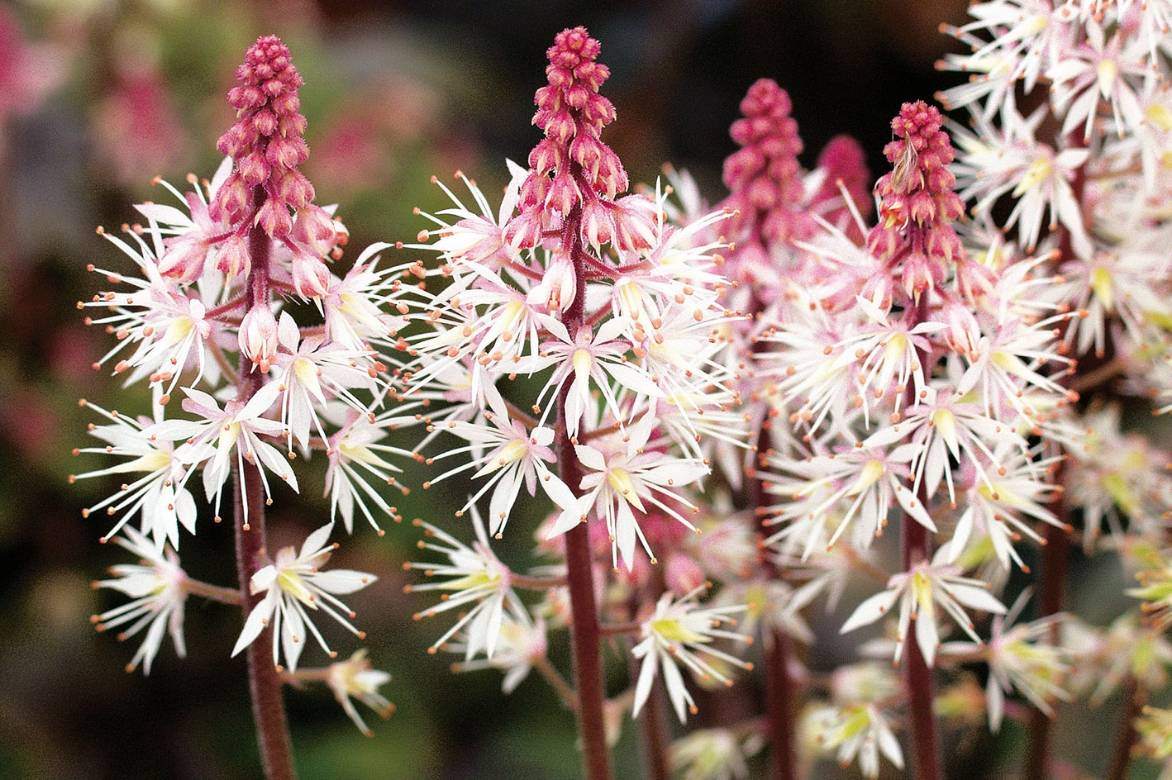
They make excellent cut flowers for delicate fresh bouquets.
Easy to grow and exhibiting good hardiness down to -15°C, Tiarellas and Heucherellas are excellent perennials for shaded, cool areas of the garden, providing an airy aspect from spring into summer.
They thrive in all cool to moist, well-drained soils. These two perennials prefer shade to partial shade and dislike very hot exposures.
Tiarellas and Heucherellas are among the best groundcover perennials: indispensable in a shady garden for dressing the bases of trees and bushes, in beds, moist rockeries or shaded borders, or even in pots or containers sheltered from strong sun.
Tiarellas are used in herbal medicine for their tonic and diuretic properties.
Main species and varieties
Not easy for a novice gardener to tell Heuchera from Tiarella! Heucherella, created in France in 1912, is actually a hybrid genus (x Heucherella) resulting from successful cross-breeding between its cousin Heuchera, another plant with ornamental foliage, and its sister Tiarella. Both are excellent hardy groundcover plants with magnificent coloured, evergreen foliage, and with long flowering.
There is now a multitude of cultivars, small (10–15 cm high), medium-sized (20–45 cm) or giant (50–90 cm tall when in flower), with plain, bicoloured, variegated, veined or marbled foliage, in pale, vintage or deep colours, capable of satisfying even the most blasé gardeners. These new heucherella varieties are in most cases patented (‘Brass Lantern®’).
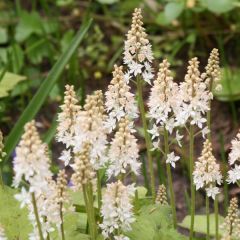
Tiarella cordifolia
- Flowering time May to July
- Height at maturity 20 cm

Heucherella Sweet Tea
- Flowering time June, July
- Height at maturity 60 cm
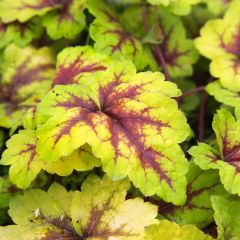
Heucherella Stoplight
- Flowering time June, July
- Height at maturity 40 cm
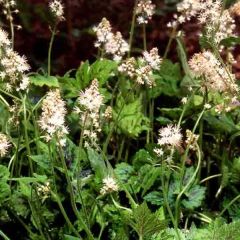
Tiarella Running Tiger
- Flowering time May to August
- Height at maturity 30 cm

Heucherella Golden Zebra
- Flowering time June, July
- Height at maturity 40 cm

Tiarella wherryi
- Flowering time June to August
- Height at maturity 30 cm

Heucherella Brass Lantern
- Flowering time July to September
- Height at maturity 35 cm

Heucherella Redstone Falls
- Flowering time June, July
- Height at maturity 30 cm
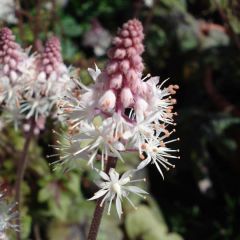
Tiarella Ninja
- Flowering time May to July
- Height at maturity 30 cm

Heucherella Copper Cascade
- Flowering time July, August
- Height at maturity 30 cm
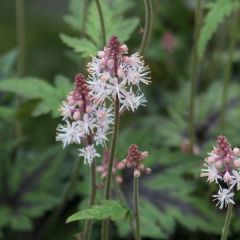
Tiarella Sugar and Spice
- Flowering time June, July
- Height at maturity 20 cm
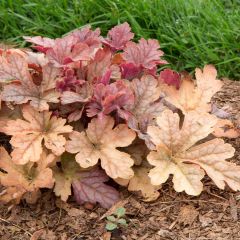
Heucherella Honey Rose
- Flowering time July to September
- Height at maturity 35 cm
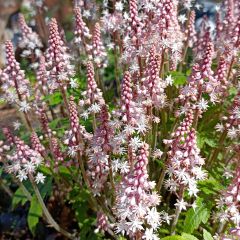
Tiarella cordifolia Pink Brushes
- Flowering time June to August
- Height at maturity 30 cm

Tiarella Sugar and Spice
- Flowering time June, July
- Height at maturity 20 cm
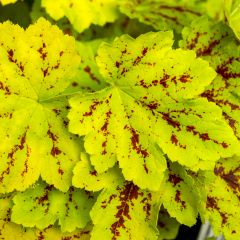
Heucherella Solar Power
- Flowering time June, July
- Height at maturity 35 cm

Heucherella Citrus shock
- Flowering time July, August
- Height at maturity 35 cm
Discover other Tiarellas and Heucherellas
View all →Available in 0 sizes
Available in 1 sizes
Available in 1 sizes
Available in 1 sizes
Available in 1 sizes
Available in 2 sizes
Available in 1 sizes
Available in 2 sizes
Available in 2 sizes
Available in 1 sizes
Planting
Where to plant tiarellas and Heucherellas?
Resistant to frost (sometimes down to -20°C), better than to drought, Tiarellas and Heucherellas are rather suitable for cool temperate climate. For these plants that appreciate freshness, cultivation will be difficult in Mediterranean climate.
They need a rich, humus-bearing soil, remaining always cool in summer but always well drained, especially during winter. In soils that retain too much moisture their roots risk rotting; it is preferable to plant them on a raised bed or a bank.
They thrive in partial shade, dreading above all hot exposures likely to scorch their attractive foliage. They nevertheless need a few hours of sun each day to ensure good flowering.
Once well established, Heucherellas can however tolerate a dry shade under the cover of trees and bushes.
Stoloniferous varieties will quickly occupy the space given, being able to rapidly cover a large surface.
Clumps increase over time but remain always very easy to control.
They are also useful to limit weed proliferation and would advantageously replace short grass meadow in less accessible areas of garden. These perennial groundcover plants will save weeding or will take over from rather sad spring bulbs after flowering.
These saxifragaceae are perfect to bring colour and brightness to cool shade, at edge of light deciduous wood. Their use depends on cultivar size: small (10 to 15 cm high), medium (20 to 45 cm) or giant (50 to 90 cm high in flower). They reveal their full potential in the role of groundcover in understorey to dress shaded areas, banks, as riverbank plants, to colonise massifs of bushes quickly or to crown a low wall even in winter.
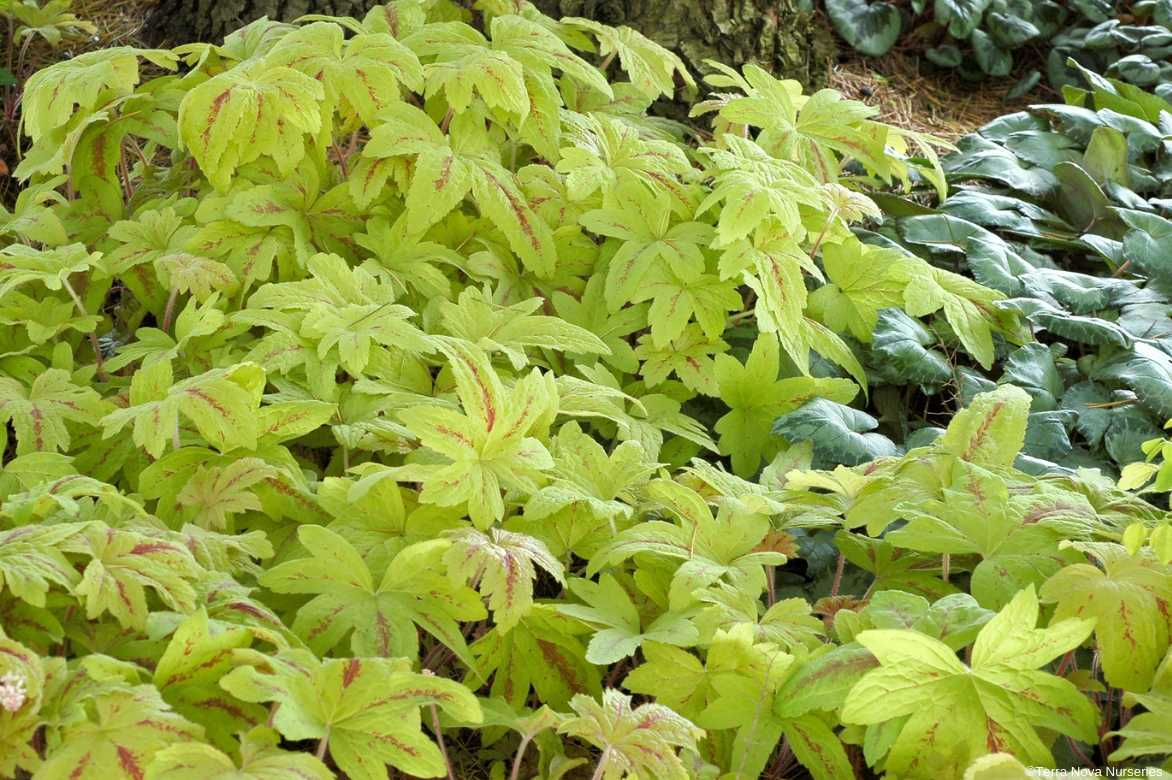
Tapetum of Heucherella ‘Sunrise Falls’ with superb lemon-yellow foliage in spring then purplish in autumn!
They also compose window boxes, pots, urns or hanging baskets in shade from which they will escape gracefully!
When to plant tiarellas and Heucherellas?
Planting tiarellas and Heucherellas is done in autumn from September to November to encourage rooting before winter or in spring in cold regions from March to April, outside frost and drought periods.
How to plant tiarellas and Heucherellas?
Easy to grow, they do well in ground or in containers.
In open ground
These perennial plants with strong spreading habit will thrive more in soil rich in humus. Add a good spadeful of well-rotted compost or manure at planting. In heavy soil, add coarse river sand to improve drainage.
Space plants about 30 to 40 cm apart and allow 6 to 9 buckets or plug plants per m2 to create a nice dense tapetum. Plant our plug plants if possible on receipt.
To colonise a neglected corner of garden, under trees or bushes for example, or to advantageously replace short grass meadow in lightly trafficked, shaded areas, you can also plant tiarellas and Heucherellas en masse. You will be secure for many years!
- Dig a hole 3 to 5 times wider than rootball
- Loosen soil well
- Place plant in centre of hole without burying collar too deep, keeping it slightly below soil surface
- Cover rootball with a mix of potting compost, garden soil and compost
- Firm down
- Optionally apply a mulch of organic material
- Water copiously then regularly until established
In a pot
- In a container, spread a layer of clay balls over a quarter of the height
- Plant tiarella or Heucherella, collar level with substrate, in a well-drained potting mix for flowering plants (geranium type)
- Keep rootball always slightly moist
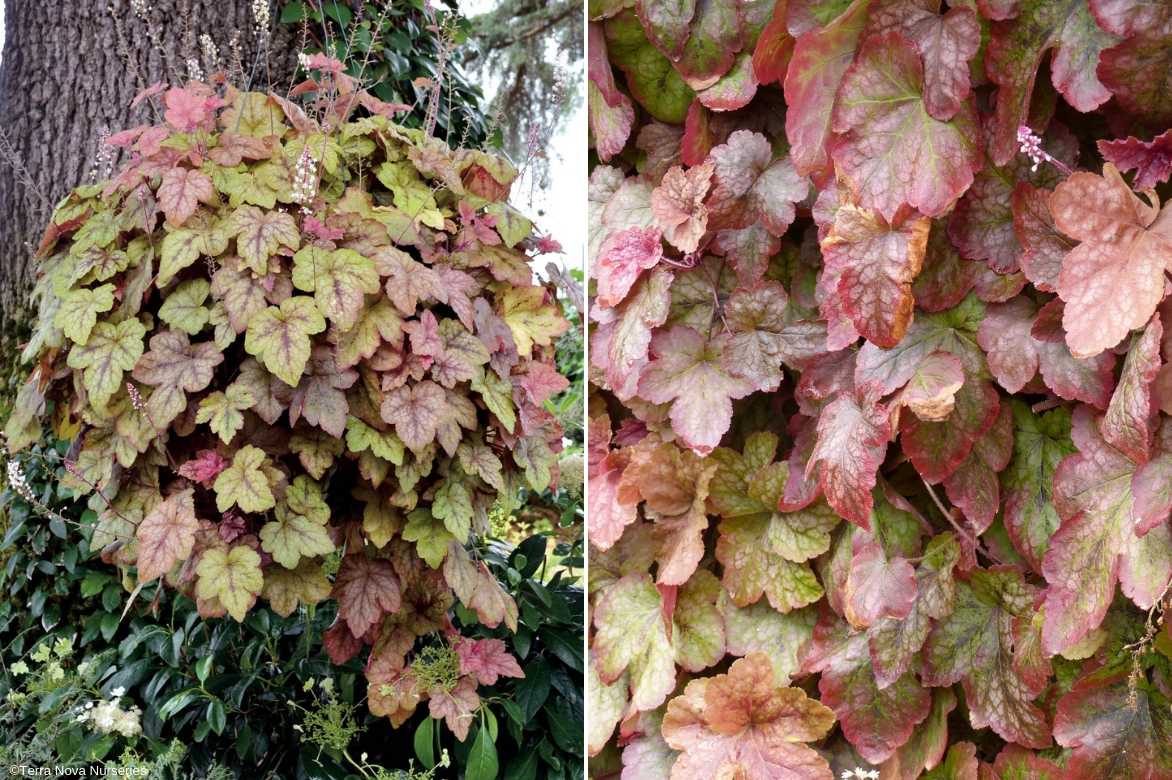
Hanging basket of Heucherella ‘Redstone Falls’
More advice to plant our plug plants on our blog!
Read also
Care of perennial plantsMaintenance, pruning and care
Tiarellas and heucherellas (x Heucherella) require very little care to remain attractive all year round. They have only a few essential needs.
They tolerate any type of well-drained soil, provided they do not lack water in summer.
In pots as in open ground, ensure to maintain sufficient moisture at the base. Soil must always remain sufficiently cool throughout summer. Mulch the stumps in spring to keep the roots cool during summer. In regions with severe winters, renew this vegetal mulch (pales of flax…) in autumn to protect them from hard frosts.
In pots, moderate watering in winter and do not let water stand in saucers. It may also be useful to mulch plants in pots.
If rains are scarce, water regularly the first year after planting then 1–2 times a week in case of heatwaves or prolonged drought. Afterwards, these plants will become more tolerant of short dry spells.
They appreciate soil rich in humus. In poor soil, add each year at the start of spring a good layer of well-rotted compost, lightly forking it in around the base of the plants.
Remove faded flower stalks and wilted leaves as they appear.
At end of winter, around February–March, clean the clump by removing leaves damaged by cold when new leaves are just starting to emerge.
If you want to limit their spread, pull out excess stolons of stoloniferous varieties.
Divide clumps every 3–4 years in October or March to maintain vigour.
Repot every two or three years, tiarellas and heucherellas grown in pots.
Diseases and potential pests
If heucherella has no enemies, its cousin tiarella can be more vulnerable to slugs and snails that relish its young shoots in spring. Discover our natural solutions to keep these pests away.
Potted specimens can be more susceptible to vine weevils (Otiorhynchus) that devour roots and ‘punch’ the leaf margins: burn overly infested young plants and spray tansy decoctions as a preventive measure.
Likewise, it can be fairly susceptible to powdery mildew during summer. For prevention: consult our factsheet How to treat and prevent powdery mildew or white disease.

Abundant flowering of tiarella plants
Multiplication
Heucherella and Tiarella multiply easily by clump division or by separating rooted stolons in autumn or spring. Tiarella can reproduce by spontaneous sowing in garden, which is not the case for Heucherella, which is sterile.
Clump division
Division helps preserve clumps when rhizomatous stems age.
- Using a garden fork, lever up part of the stump
- Divide it into several pieces, each with a few roots and a leaf shoot
- Replant immediately in ground or pot
Separating stolons
- With a spade, separate a rosette of leaves attached to the parent plant
- Dig up the stolon
- Transplant immediately into moist soil so that the base of the seedling is slightly buried
- If carried out in autumn, pot up and keep frost-free until spring
Using and combining them in the garden
Heucherellas and Tiarellas are indispensable in shade gardens, in pink gardens or romantic settings, in beds or wooded sites with their such colourful foliage and pastel, feathery inflorescences that brighten the coolest corner. With their graceful habit, they help lighten somewhat heavy shade perennials or coarser foliage and serve as backdrop for more spectacular or taller flowers.
Excellent ground-cover, highly decorative in coloured woodland settings, under trees they are easy to combine with brunneras and pulmonarias and will look magnificent in family combination with Heuchera.
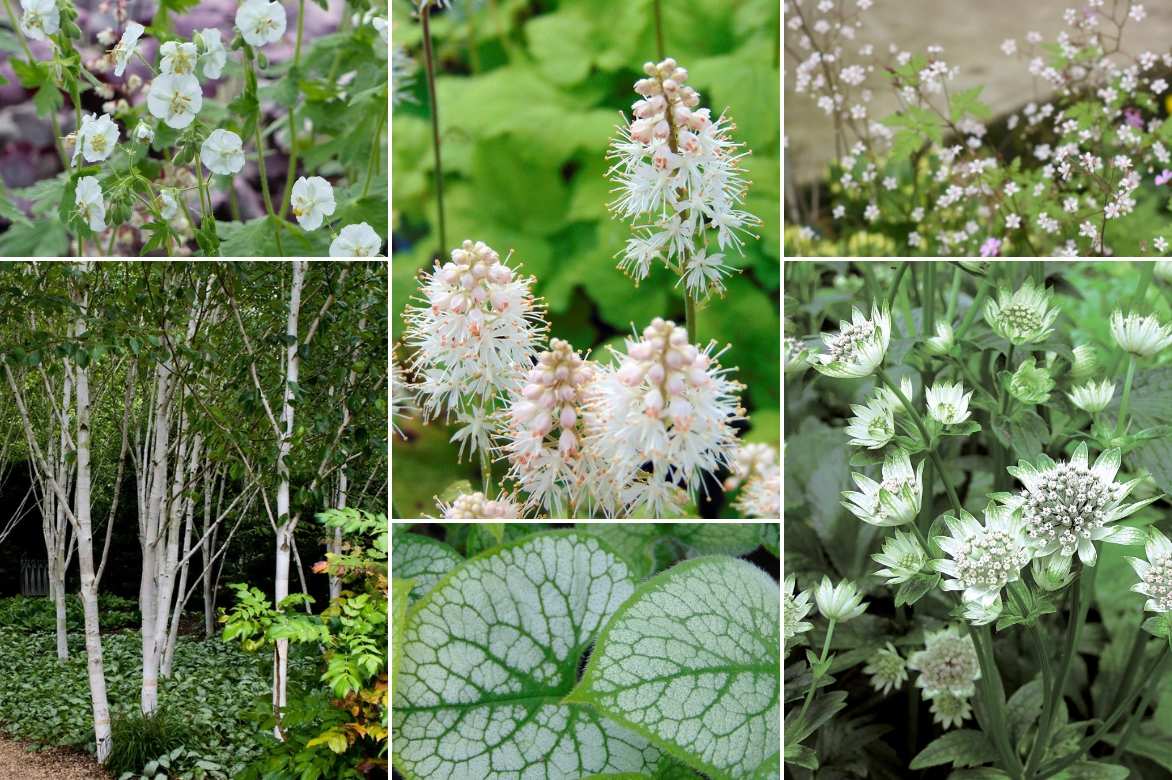
Example of a woodland combination: Geranium phaeum ‘Album’, Betula utilis var jacquemontii, Tiarella cordifolia ‘Moorgrun’, Brunnera macrophylla ‘Jack Frost’ (or another variety with silvery foliage), Saxifraga umbrosa and Astrantia ‘Star of Billion’ (or ‘White Giant’)
At edge of a cool woodland, they are perfect with their shade companions such as ferns, ligularias, Silver candles, Epimedium, shade hardy geraniums or filipendulas.
Classic partners of Tiarellas and heucherellas, astilbes, alchemillas and hostas enjoy same growing conditions and will create a striking display in a bed with dappled shade.
Under trees, they are welcome among other ground-cover perennials for shade to create a carpet of subtle colours and textures with wood anemones, violets, creeping lysimachia, columbines, Asarum…
They form a classic, fresh picture with many spring bulbs such as snowdrops, hyacinths, daffodils, primroses and later tulips and colchicums.
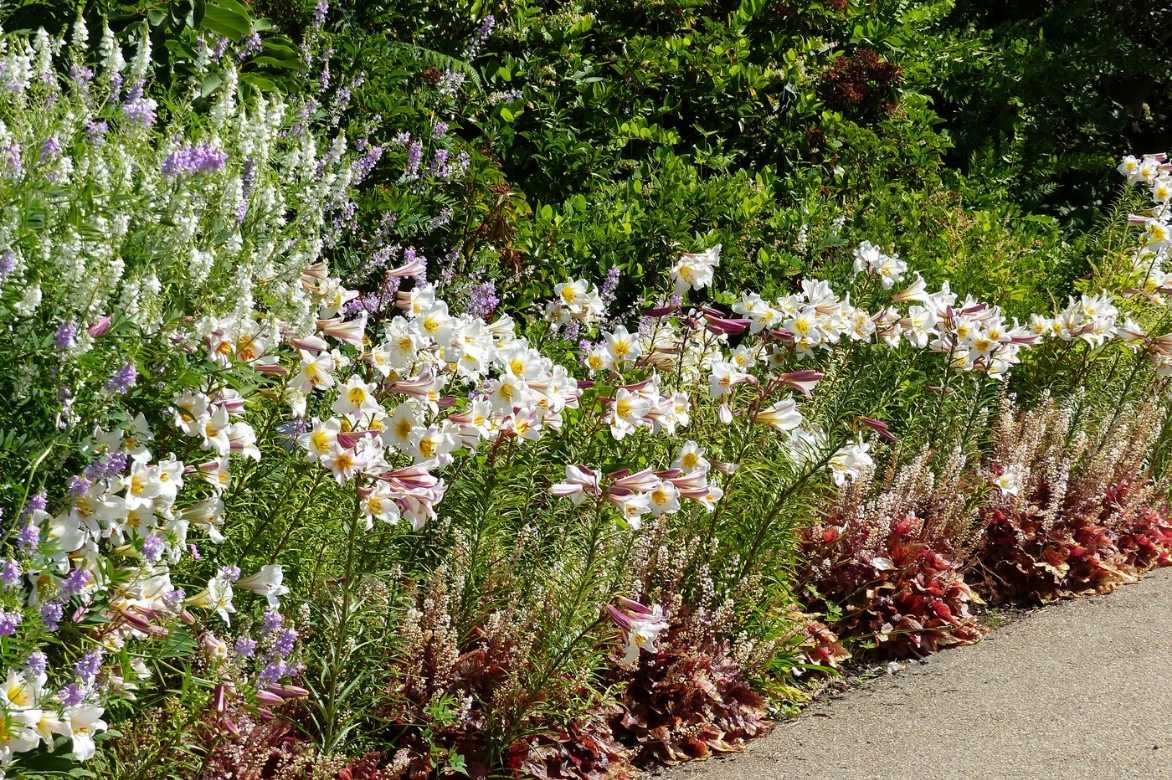
Example of a border combination: Galega orientalis, Lilium regale and Heucherella ‘Brass Lantern’
In a romantic-toned border, they will grow among white or pink azaleas or cyclamen. At front of a border, they will pair nicely with columbines, bleeding hearts, pink geums and small violas.
Their foliage, often turning reddish-bronze in autumn, harmonises happily with wide range of trees and bushes with late colouring such as maples, barberries and deciduous euonymus, smoke trees or ornamental grasses with autumnal hues like Pennisetum setaceum ‘Rubrum’ and Miscanthus sinensis ‘Little Miss’’
In a pot, new Heucherella hybrids will look superb in flowering mixes alongside small, airy grasses such as Carex and stipas or with alyssums, campanulas, daffodils in spring and small cyclamens in winter.
Useful resources
- Discover 4 pairing ideas for Tiarellas and Heucherellas
- Read our article to find out how to choose a Tiarella or Heucherella
- Because there’s always a slightly bare corner in the garden… Think of groundcover perennials and try our tried-and-tested favourites
- Do you have a dark garden, a shaded corner that’s hard to make the most of? Discover our tips, plants and solutions for a shade garden
- Discover Heucheras, these perennials so close to Tiarellas and Heucherellas!
- Do you have a woodland area to plant? Take inspiration from our advice sheets “What to plant under my trees?” and our suitable plants and solutions
- Subscribe!
- Contents
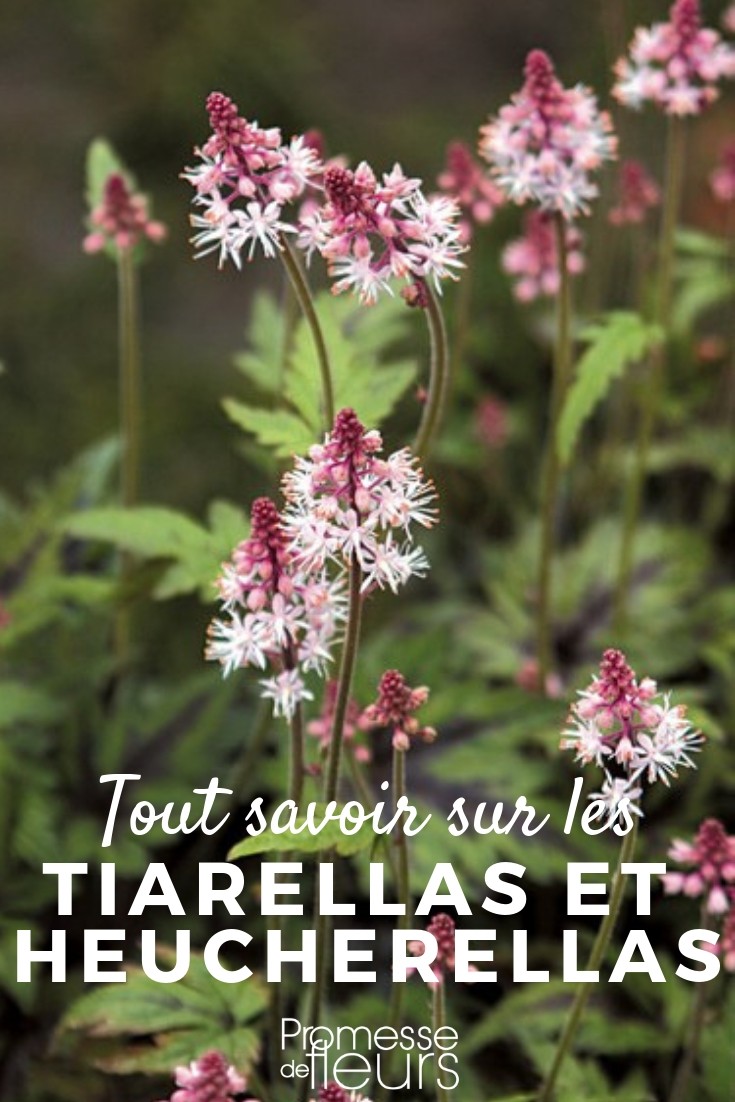
































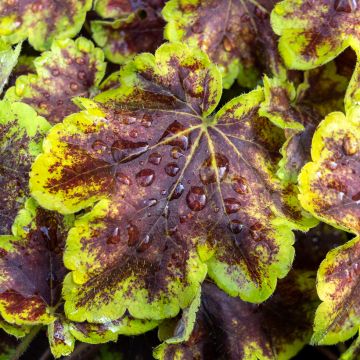
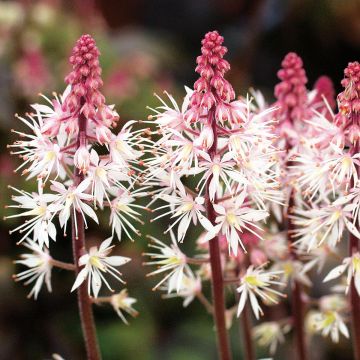
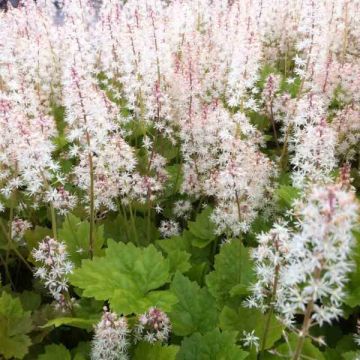
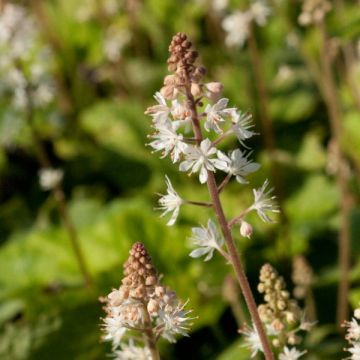


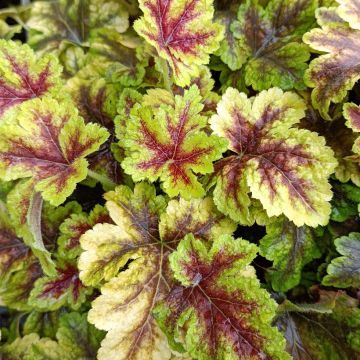


Comments